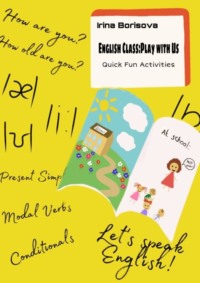Czytaj książkę: «English Class: Play With Us. Quick Fun Activities»
Cover designer Arina Zheleznyh
© Irina Borisova, 2021
© Arina Zheleznyh, cover design, 2021
ISBN 978-5-0055-7479-4
Created with Ridero smart publishing system
Introduction
English Class: Play With Us contains a collection of games and activities for teaching and revising English. It includes vocabulary, pronunciation, speaking, writing and grammar activities ranging from beginner to advanced level. Teachers may find them helpful when doing certain themes of the academic curriculum, as well as use them as a short break before proceeding to the next «serious» exercise in the textbook. Another good idea is to employ some of those activities for warming up. Besides, if you organize such a quick fun at the end of the class, the students will definitely leave the classroom in a great mood which, undoubtedly, will exert positive influence on their English studies.
The games and activities have been grouped into five categories in accordance with the aspect they belong to and the skill they develop:
• Vocabulary
• Pronunciation
• Grammar
• Speaking
• Writing
Some of the activities described below are meant to be carried out as whole class activities. Others are designed for pair work or group work. Working with classmates makes the lesson more lively and enjoyable. Dealing with cards, a blackboard, crayons and other stuff involves more senses in the learning process making it, therefore, more effective.
All the activities introduced in the book have simple and clear rules and do not require much time to do. Time-limit is suggested for each activity though it depends on the group and may vary. The assumed class size is about 15 students. It is important not to spin out the activity, stop it when the time is over and sum up the results, preferably with the whole class.
Finally, there are games in this book based on popular pastimes, such as playing crocodile. Both adults and children love these games, they inalterably produce a cheerful atmosphere in the class. Alongside with this, you will find some new ideas that might be of interest to your students and help them learn English with fun and pleasure.
For feedback, please, contact: engteachirina@gmail.com
Vocabulary fun
Word Auction
Core language: Any parts of speech, word groups referring to a definite topic etc.
Level: Beginners-advanced
Number of students: Any
Stuff needed: A toy wooden hammer for operating the process. Another good idea is to use a toy rubber hammer producing a funny squeaking noise. But if you do not have a hammer, simply use a pencil or a pen.
Time: 7 minutes
People/characters involved:
– “An auctioneer” – the person conducting the “auction”. The job is usually done by the teacher. It may also be performed by a student if the game has already been played in the class before.
– “Bidders” or “participants” of the “auction” – all the students.
Procedure: The auctioneer announces the topic of the auction. The participants call out words on the topic given. Every word is followed by a number (one, two, three) and certain «fillers» uttered by the auctioneer in that special rhythmic- repetition- auction -chant manner and a blow of his/her hammer. The bidder who says the last item wins the game.
Example:
The auctioneer: Ladies and gentlemen! The topic of today’s auction is «Jobs». You are to call out as many names of jobs, professions and occupations as possible while I am counting from one to three. The auction ends the moment I say «Three!» The participant who says the final word is the winner. So, the subject is «Jobs». Right, here we go!
Student A: Doctor!
The auctioneer: Doctor one!…
Student B: Pilot!
The auctioneer: Pilot one!…
Student C: Teacher!
The auctioneer: Teacher one! … Teacher two!…
Student D: Builder!
….
Student N: Conductor!
The auctioneer: Conductor one! … Conductor two! … Conductor three! … Done! The winner of the auction is Student N!
Variations: The range of topics for Word Auction game is immense. Here are just a few suggestions below:
• Goods and services: “Clothes”, “Food and drinks”, “Hotels”, “Restaurants and cafes”, “Real estate”
• Art: “Literature”, “Music”, “Fine arts”
• Education: “Classroom activities”, “School subjects”
• Health and Medicine
• Climate and weather
• Sports
• Leisure activities
• Hobbies and interests
• The mass media
• Language issues: “Adjectives beginning with “s”, “Irregular verbs” etc.
Some helpful ideas: It seems to be a nice idea to present the winners with little prizes such as sweets, candies or chocolates.
Word Categories
Core language: Word groups referring to definite topics
Level: Beginners-advanced
Number of students: Any
Stuff needed: A white/blackboard
Time: 7 minutes
People/characters involved:
– A presenter – the teacher or one of the students.
– Participants – all the students.
Procedure: The presenter writes/types a list of category headings on the board. The participants choose a letter of the English alphabet. Now they should name at least two words for each category beginning with this letter.
Example:
Categories
Animals
Clothes
Food & Drinks
Geography
Weather & Climate
Classroom
Hobbies and Interests
Art
The letter chosen: T
Students:
Animals: tiger, tapir
Clothes: trousers, T-shirt
…
Variation: The presenter writes/types a list of category headings on the board. The participants should think of five words fitting into each category.
Example:
Categories
Animals
Clothes
Food & Drinks
Classroom
Hobbies and interests
Geography
Climate and weather
Art
…
Students:
Animals: cat, dog, elephant, wolf, mouse
Clothes: dress, shirt, jeans, trousers, T-shirt
…
Some helpful ideas: The list of categories can certainly be extended. You could find the following tips useful: «Sports», «Health and Medicine», «Music», «Literature», «Fine arts», «Film industry», «Transport».
You may also introduce or add your own items to the category list.
Darmowy fragment się skończył.
